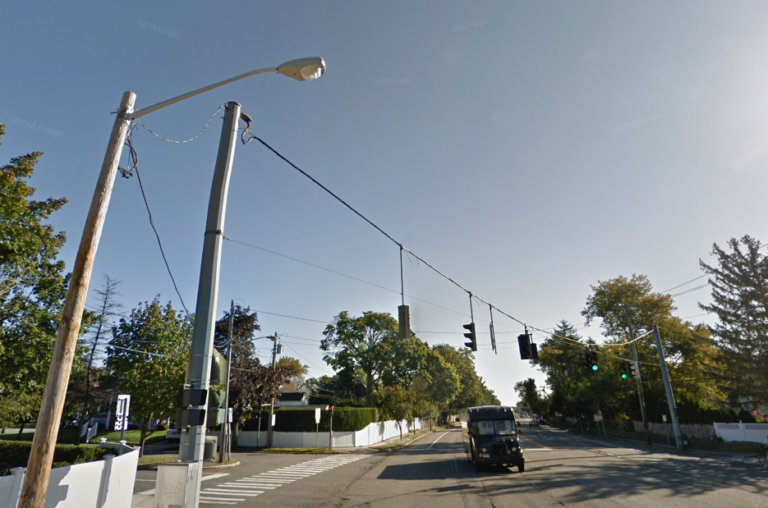
The Town of North Hempstead installed 80 new light emitting diode bulbs along Hillside Avenue in New Hyde Park, town officials announced on Wednesday, in a move aimed to save money and boost safety.
The new LED high-pressure sodium streetlight fixtures, which run from Denton Avenue to the New York City border on Hillside Avenue, replace older incandescent 250-watt fixtures, ranging between 30 and 40 years old, with 110 watt ones that have a light temperature of 4000K.
The new lights are expected to cut related electrical costs by 56 percent – more than half.
“Replacing existing street lighting on Hillside Avenue with more reliable, efficient and long-lasting LEDs improves the lighting, visibility and driving safety of the neighborhood,” Town Supervisor Judi Bosworth said, “all while reducing electrical costs for our taxpayers.”
Town Councilwoman Lee Seeman, whose district includes Lake Success, North New Hyde Park, Floral Park and other areas, echoed the safety aspects of the project.
“These lights will increase visibility at night for both drivers and pedestrians, as well as result in making our neighborhoods safer,” Seeman said.
The town decided to do this project on July 20 this year, according to a town spokeswoman, but this isn’t the first time North Hempstead moved to replace lights with LED bulbs.
Back in December 2014, North Hempstead replaced aging incandescent lighting fixtures with LED ones in the New Salem area of Port Washington, reducing the wattage from 180 to 26 per bulb.
New LED street lighting also came to Garden City Park about a year ago. North Hempstead installed 49 new LED street lights along Hillside Avenue from Foch Boulevard to Denton Avenue.
The previous fixtures were 250 watts; the LED ones measure 110.
Additionally, in 2017, 63 streetlights with LED, with a color temperature of 4000K, were installed in parts of Westbury and Carle Place in October last year.
“As places need bulb replacing, we’re doing the LED lights,” Carole Trottere, a town spokeswoman, said on Wednesday.
Numerous North Shore villages have also installed or are actively considering converting streetlights to LED.
Kings Point is currently in discussions to replace 200 streetlights with LED bulbs, for example, and villages like North Hills, East Williston, Roslyn Harbor have also invested time in trying to get LED lights.
Thomaston approved LED street lights in 2015, Great Neck Plaza aims to install them, and the Village of Great Neck has replaced all of its more than 800 incandescent streetlights with LED ones.
Additionally, New York Gov. Andrew Cuomo has pushed for LED streetlights to be installed throughout the state; his goal is to have 500,000 installed by 2025.
But it also comes as a Great Neck resident’s lawsuit against the Village of Great Neck may move forward. In that suit, she claims a light fixture shining into her home has robbed her of the use of her home and that she wants an injunction against it.
According to the American Medical Association, some LED lights emits high amounts of blue light that appears white and can, in turn, create nighttime glare, suppress melatonin at night, and affect the circadian rhythm.
Among is recommendations are minimizing blue right light, shielding fixtures, and using 3,000K lights and lower.
Jesse Scott, a New York Power Authority representative working with Kings Point, when asked about the perceived health effects of LED lights, said that a study done by the American Medical Association had worried people because of an impact on the circadian rhythm and general health.
However, that study looked at prolonged and direct exposure – not how the LED streetlights are typically implemented, he said.
“When they’re designed properly, LED light is very directional, and it’s supposed to illuminate the roadway for safety, for pedestrians, for vehicles,” Scott said.







4000K LED light bulbs are a disaster for humans and all other living creatures. These bulbs are destroying our ability to sleep and enjoyment of the places where we live. I fully support Ms. Youngblood and her lawsuit and truly hope that she wins. Everybody needs to raising the alarm about LED lights. They need to be 2700K or less.
This has got to stop. It has been long established that blue rich lighting is detrimental to both human health and the environment. I won’t elaborate further as a simple Google search will reveal all. Also, contrary to what we see written here, lighting does not necessarily improve safety and security. What we need are street light reduction programmes. There are alternative ways of making roads safer at night without naïve recourse to street lighting. If lighting in residential and suburban areas is deemed necessary, then it should be motion operated and subject to al 11p.m. till dawn curfew. The minimum wattage required to do the job should be employed. Dimming is not an option as the colour temperature is not reduced so it will still be harmful. The colour temperature should never exceed 2200K, and preferably less. All lights should be fully recessed into their housings to prevent intrusion into properties, and in these areas should never exceed first floor height for the same reason.